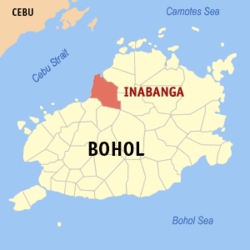Inabanga | |
|---|---|
| Municipality of Inabanga | |
 | |
 Map of Bohol with Inabanga highlighted | |
Location within the Philippines | |
| Coordinates: 10°02′N124°04′E / 10.03°N 124.07°E | |
| Country | Philippines |
| Region | Central Visayas |
| Province | Bohol |
| District | 2nd district |
| Barangays | 50 (see Barangays) |
| Government | |
| • Type | Sangguniang Bayan |
| • Mayor | Dexter M. Ancla |
| • Vice Mayor | Hermogenes C. Cenabre, Jr. |
| • Representative | Maria Vanessa Aumentado |
| • Municipal Council | Members |
| • Electorate | 33,493 voters (2025) |
| Area | |
• Total | 125.63 km2 (48.51 sq mi) |
| Elevation | 9.0 m (29.5 ft) |
| Highest elevation | 141 m (463 ft) |
| Lowest elevation | −3 m (−10 ft) |
| Population (2024 census) [4] | |
• Total | 49,133 |
| • Density | 390/km2 (1,000/sq mi) |
| • Households | 11,015 |
| Economy | |
| • Income class | 3rd municipal income class |
| • Poverty incidence | 20.79 |
| • Revenue | ₱ 239.7 million (2022) |
| • Assets | ₱ 883 million (2022) |
| • Expenditure | ₱ 160.1 million (2022) |
| • Liabilities | ₱ 213.9 million (2022) |
| Service provider | |
| • Electricity | Bohol 1 Electric Cooperative (BOHECO 1) |
| Time zone | UTC+8 (PST) |
| ZIP code | 6332 |
| PSGC | |
| IDD : area code | +63 (0)38 |
| Native languages | Boholano dialect Cebuano Eskayan Tagalog |
| Website | www |
Inabanga, officially the Municipality of Inabanga (Cebuano : Munisipyo sa Inabanga; Tagalog : Bayan ng Inabanga), is a municipality in the province of Bohol, Philippines. According to the 2020 census, it has a population of 48,534 people. [6]
Contents
- Geography
- Barangays
- Climate
- Demographics
- Economy
- Tourism
- Infrastructure
- Transportation
- Utilities
- Welfare
- Education
- Notable personalities
- References
- External links
Inabanga celebrates its fiesta on 29 and 30 June, to honor the town patron, Saint Paul. [7]
Inabanga was the site of the 2017 Bohol clashes between Philippine security forces and Moro ISIL-affiliated militants led by members of the Abu Sayyaf.







